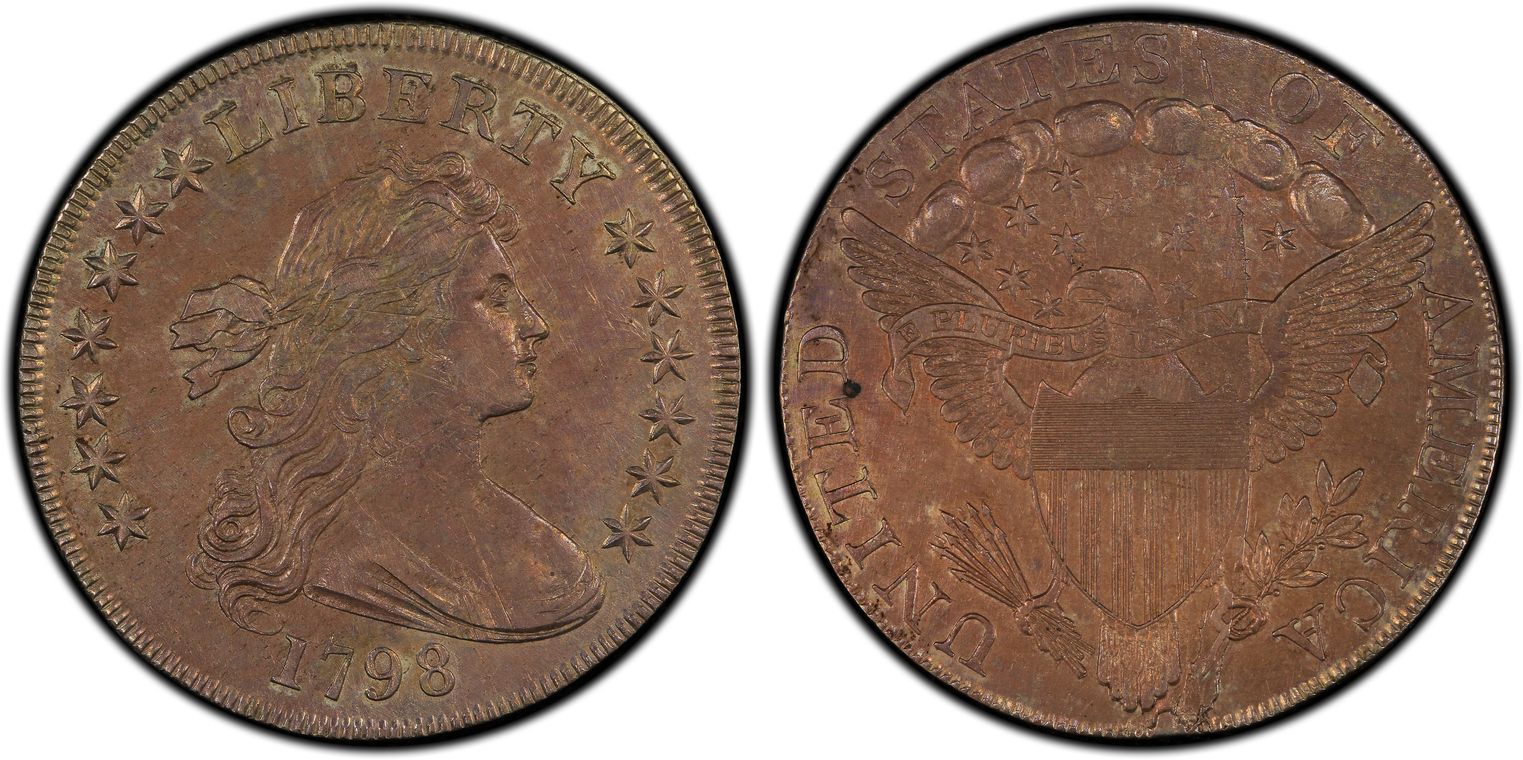1798 $1 BB-93 AU53 认证号27942484, PCGS号40013
专家评论
Q. David Bowers
The following narrative, with minor editing, is from my "Silver Dollars & Trade Dollars of the United States: A Complete Encyclopedia" (Wolfeboro, NH: Bowers and Merena Galleries, Inc., 1993). Note: the Notable Specimens list should be used with caution - it has been updated in my 2013 edition of "The Encyclopedia of United States Silver Dollars 1794-1804."B-5. H-5.
OBVERSE 3
See description under 1798 BB-92. The top of the 1 in date is straight in BB-93, as in BB-92.
Obverse die used to strike 1798 BB-92 (earliest state; more detail to highest wave of hair than on BB-93 or BB-94), BB-93, and BB-94 (top left of 1 in date is "lumpy"; possibly the latest state). Striking order probably BB-92, BB-93, BB-94.
REVERSE D
This variety is usually instantly identifiable by the heavy reverse vertical die crack which runs from rim to rim on most known specimens. Because of this crack, all examples seen are weak at the center of the reverse, but somewhat stronger in the area to the right of the crack. Line star pattern. Star is very close to the outside of point of upper part of eagle's beak; star ray points to right side of left upright of B in PLURIBUS. Right serif on foot of first T in STATES lower than left foot of adjacent A; right serif on foot of second lower than adjacent serif of E. Bases of letters AME and RI closer than ER. Berry below and distant from left side of serif of right foot of A. Only 10 arrows, and three heads additional without sticks.
Reverse die used to strike 1798 BB-93 only.
DIE STATES
Die State I
Perfect dies without cracks. May not exist. Die State IIObverse die with tiny crack from rim to upper right serif of T in LIBERTY. "Virtually no breaks" on reverse. Cf. Spies Collection (Stack's, 1974), VF, there called "probably unique."
Die State III
Obverse as above. Reverse with die crack along right side of shield entirely across reverse, as described by Bolender. Crack from bottom of left upright of M in AMERICA, under M, to partly under E. Crack from border past second S of STATES (between S and bisecting crack). Die cracks up between lower right of tail and where bisecting crack reaches bottom border. The usually seen die state.
COLLECTING NOTES
Despite the inclusion of three specimens in the 1975 ANA Convention sale (Superior), the BB-93 variety is quite rare today. I believe that only 30 to 50 exist. In 1950, the situation was far different when Bolender wrote this: "Haseltine had found but a single specimen (Fair), and I have seen but one. Excessively rare. Rarity 7." This is the old story againA specimen is considered rare, then collectors search for it, and additional coins come to light.
NOTABLE SPECIMENS
Hollinbeck-Kagin Specimen. AU-55. Hollinbeck.-Kagin Sale, June 1970608. "A choice virtually Uncirculated specimen showing only barest friction."
Willasch Specimen. VF-35. Superior, H. Roland Willasch Collection, 1990476. VF-35. "Cleaned long ago with toning starting to form about the periphery."
Everson and Faught Specimen. VF-35. Bowers and Merena, Everson and Faught Collections, 19882219. VF-30 to EF-40. "A beautiful specimen with rich, glossy surfaces and splendid coppery, violet, and rose toning. Most design features are bold. 75% or more of Miss Liberty’s hair details are sharp, and most of the eagle's wing feathers are strongly defined. All stars, letters, and numerals on the obverse are exceptionally bold. Mint-caused adjustment marks are present on the obverse."
Four Landmark Collections Specimen. VF-30/20. Bowers and Merena, Four Landmark Collections Sale, 19891955. "Obverse toned a pale silver gray, while reverse is a lighter shade of gray. Split grading is accounted for by the extremely late state of the reverse, the die having cracked longitudinally from 12:00 to 6:00. Clearly, the advanced state of the die accounts for the rarity of the combination. While the obverse strike appears to have been sharp, the reverse is indeterminable because of the advanced state of the break."
Austin Specimen. VF-20. K. P. Austin Collection. AJ. Ostheimer, 3rd Collection. Superior, 1975:854. Reverse with vertical die break along right side of shield entirely across reverse. "VF-20, clean, with a touch of gold."
Green Specimen. VF-20. Col. E.H.R. Green Collection. M.H. Bolender Collection. AJ. Ostheimer, 3rd Collection. Lester Merkin, 1968248. "VF, clean, pale gold tone, tiny rim planchet defect."
December Sale Specimen. VF-20. Stack's December Sale, 1987:1520. "Light scratches, largely concealed by gray violet toning."
Spies Specimen. VF-20. Stack's, W. Earl Spies Collection, 1974:46. VF.
PCGS #
40013
设计师
Robert Scot
边缘
Lettered: HUNDRED CENTS ONE DOLLAR OR UNIT
直径
40.00 毫米
重量
27.00 克
铸币数量
287536
金属成分
90% Silver, 10% Copper
更高评级数量
0
评级较低的钱币数量
5
地区
The United States of America
价格指南
PCGS 数量报告
拍卖 - PCGS 评级的
拍卖 - NGC 评级的





















